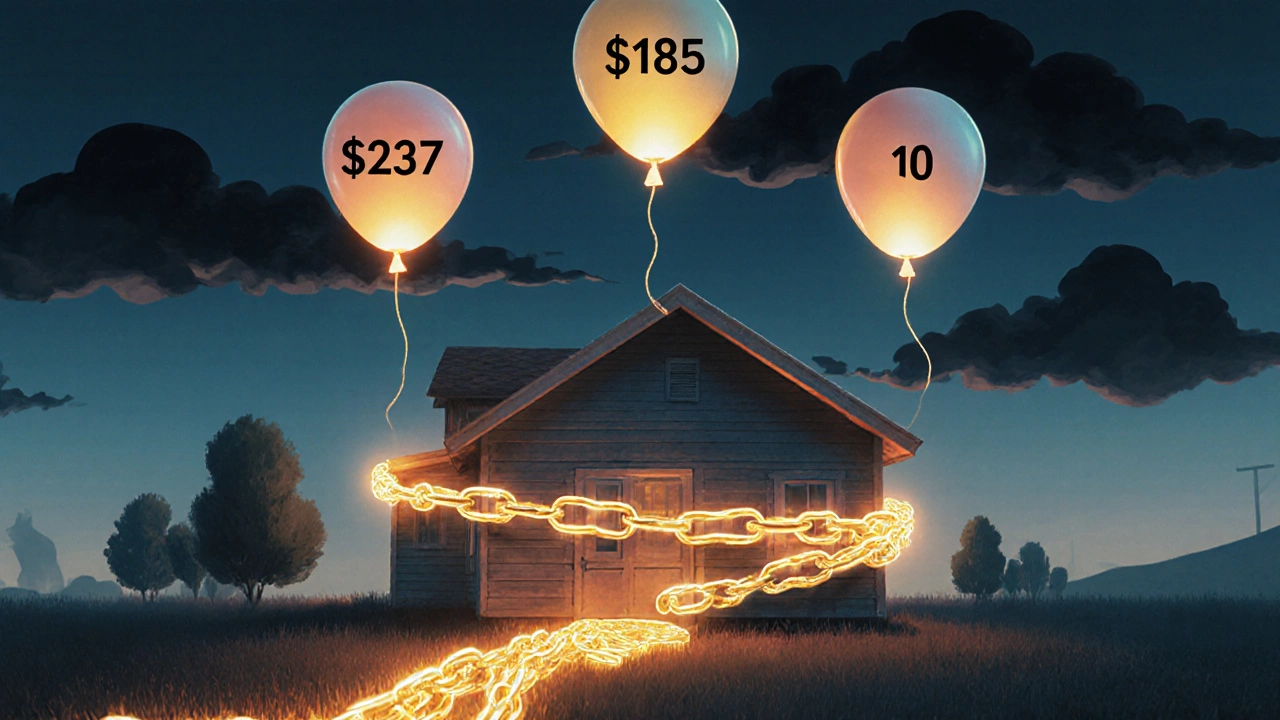What is the Payment on a $20,000 Home Equity Loan?
 Oct, 30 2025
Oct, 30 2025
Home Equity Loan Payment Calculator
Calculate Your Monthly Payment
Enter your loan details to see how much you'll pay each month
Payment Details
Understanding Your Payment
Your monthly payment depends on your interest rate and loan term.
For example: At 7.5% over 10 years, you pay $237/month with $8,440 in total interest.
When you take out a $20,000 home equity loan, you’re not just borrowing money-you’re using your home as collateral. That means your monthly payment isn’t just a number on a bill; it’s tied directly to your home’s value, your credit, and the current interest rates. In Canada, especially in places like Toronto where home prices have climbed sharply over the last decade, many homeowners turn to equity release to cover medical bills, home renovations, or debt consolidation. But how much will you actually pay each month? It’s not as simple as dividing $20,000 by the loan term.
How Home Equity Loan Payments Work
A home equity loan is a lump sum you borrow against the equity you’ve built in your home. Unlike a line of credit, it has a fixed interest rate and fixed monthly payments. That means your payment stays the same every month until the loan is paid off. The two biggest factors that determine your payment are the interest rate and the loan term.
Let’s say you get a $20,000 home equity loan with a 7.5% interest rate over 10 years. Your monthly payment would be about $237. If you stretch that to 15 years, the payment drops to $185. But here’s the catch: you’ll pay more in total interest over the longer term. In the 10-year plan, you’ll pay roughly $8,440 in interest. In the 15-year plan, you’ll pay $13,300-almost $5,000 more.
Interest rates in Canada have been volatile since 2022. As of late 2025, average home equity loan rates range from 6.5% to 9.5%, depending on your credit score, loan-to-value ratio, and the lender. If you have a credit score above 700 and low debt, you might land closer to 6.8%. If your score is below 650, you could be looking at 9% or higher.
Real-World Examples
Here’s what a $20,000 home equity loan looks like under different terms:
- 5-year term, 7.5% rate: $399 per month, $3,940 total interest
- 10-year term, 7.5% rate: $237 per month, $8,440 total interest
- 15-year term, 7.5% rate: $185 per month, $13,300 total interest
- 20-year term, 7.5% rate: $163 per month, $19,120 total interest
Most lenders in Canada offer terms between 5 and 20 years. But longer terms aren’t always better. If you’re 58 and planning to retire at 65, a 20-year loan means you’ll still be paying it off in retirement. That’s risky if your income drops.
How Your Credit Score Affects Your Payment
Your credit score isn’t just a number-it’s a pricing tool. Lenders use it to decide how risky you are. A 750 score might get you a 6.9% rate. A 620 score? You could be looking at 9.2%. That difference changes your payment by $25 a month on a 10-year loan. Over 10 years, that’s $3,000 extra in interest.
One Toronto homeowner, Maria, had a $20,000 home equity loan approved at 9.1% because her credit score was 635 after a medical setback. She paid $252 a month. Two years later, after paying down other debts and improving her score to 710, she refinanced to a 7.2% rate. Her payment dropped to $201. She saved $612 in the first year alone.

What Else Goes Into the Payment?
Some lenders charge origination fees, appraisal fees, or closing costs. These don’t show up in your monthly payment, but they add to your total cost. For example, a $500 origination fee on a $20,000 loan is like paying an extra 2.5% in interest upfront.
Some lenders in Ontario offer no-fee home equity loans-but they make up for it with higher interest rates. Always ask: Is the rate higher because they waived the fee? Compare the APR (Annual Percentage Rate), not just the interest rate. The APR includes fees and gives you the true cost of borrowing.
Also, don’t forget property taxes and insurance. If you’re using your home equity loan to pay off high-interest credit cards, you’re replacing unsecured debt with secured debt. That’s smart-if you can manage the payments. But if you fall behind, you risk losing your home.
How to Calculate Your Own Payment
You don’t need a financial advisor to figure this out. Use this simple formula:
Monthly Payment = [P × r × (1 + r)^n] / [(1 + r)^n - 1]
Where:
- P = Principal ($20,000)
- r = Monthly interest rate (annual rate ÷ 12)
- n = Number of payments (loan term in years × 12)
For a $20,000 loan at 7.2% over 12 years:
- r = 0.072 ÷ 12 = 0.006
- n = 12 × 12 = 144
- Payment = [20000 × 0.006 × (1.006)^144] / [(1.006)^144 - 1] = $196
Or just use a free online calculator. The Government of Canada’s Financial Consumer Agency has a reliable one. Many banks like RBC, TD, and Scotiabank also offer free calculators on their sites.
When a Home Equity Loan Makes Sense
A $20,000 home equity loan can be a smart move if:
- You’re doing a kitchen remodel that adds value to your home
- You’re consolidating credit card debt at 20%+ interest into a loan at 7%
- You need emergency funds and have no other options
But it’s a bad idea if:
- You’re using it for a vacation or new car
- You’re already maxed out on debt
- Your income is unstable or you’re close to retirement
In Ontario, the average home equity loan borrower is between 45 and 60. Many use the money to fix up older homes before selling-or to pay for aging parents’ care. If you’re considering this, think long-term. Your home isn’t just an asset; it’s your security.

Alternatives to a ,000 Home Equity Loan
You don’t have to take out a home equity loan. Other options include:
- Home Equity Line of Credit (HELOC): You borrow only what you need, when you need it. Rates are variable, often starting around 6.5%. Monthly payments are interest-only at first, then switch to principal + interest. Good if you’re unsure how much you’ll need.
- Personal Loan: Unsecured, no risk to your home. Rates range from 8% to 18%. For $20,000, you might pay $400-$500/month over 5 years. Better if your credit is good and you want no collateral.
- Reverse Mortgage: Only for seniors 55+. You get cash without monthly payments, but you owe interest and eventually repay when you sell or move. Not ideal for a $20,000 need unless you’re 70+.
HELOCs are popular in Toronto because they offer flexibility. But if you’re disciplined and know exactly how much you need, a fixed-rate home equity loan gives you predictability.
What Happens If You Can’t Pay?
Defaulting on a home equity loan doesn’t just hurt your credit-it puts your home at risk. Lenders can start foreclosure proceedings if you miss payments for 90-120 days. In Ontario, the process can take 6-12 months, but the damage to your credit score is immediate and lasts seven years.
Before you sign, ask: What if I lose my job? What if my partner gets sick? Can I still make this payment? Build a buffer. Save three months’ worth of payments in an emergency fund before you borrow.
Final Thoughts
A $20,000 home equity loan isn’t magic money. It’s debt secured by your biggest asset. The monthly payment depends on your rate, your term, and your credit. A 10-year loan at 7% means $237 a month. A 15-year loan at 9%? $204-but you’ll pay $13,300 in interest.
Don’t just chase the lowest payment. Chase the lowest total cost. Compare lenders. Check your credit score first. And never borrow more than you can comfortably repay-even if the bank says you qualify.
If you’re unsure, talk to a fee-only financial planner. In Ontario, many offer free 30-minute consultations. They can help you weigh your options without pushing a product.
How much is the monthly payment on a $20,000 home equity loan?
The monthly payment depends on the interest rate and loan term. For example, at 7.5% over 10 years, it’s about $237. At 7.5% over 15 years, it drops to $185. Rates vary by lender and credit score, so your actual payment could be higher or lower.
Can I get a $20,000 home equity loan with bad credit?
Yes, but you’ll pay more. Borrowers with credit scores below 650 often face interest rates of 9% or higher. This can push monthly payments up by $30-$50 compared to someone with a score over 700. Some lenders may also require a lower loan-to-value ratio, meaning you need more equity in your home.
Is a home equity loan better than a personal loan for $20,000?
It depends. A home equity loan usually has a lower interest rate because it’s secured by your home. But if you miss payments, you risk foreclosure. A personal loan is unsecured, so your home isn’t at risk-but rates are higher, often 8-18%. If your credit is strong, a personal loan might be safer. If your credit is weak, a home equity loan might be your only low-rate option.
How long does it take to get approved for a home equity loan in Canada?
Approval typically takes 2 to 6 weeks. The process includes an appraisal of your home, credit check, income verification, and legal review. Some online lenders offer faster approvals (under 10 days), but they may charge higher fees. Banks like RBC and TD take longer but often offer better rates.
Are there penalties for paying off a home equity loan early?
Some lenders charge prepayment penalties, especially if you pay off the loan within the first 2-3 years. Always ask about this before signing. Many Canadian lenders, especially credit unions, don’t charge penalties. Check your loan agreement carefully. Paying early saves you interest, so it’s worth negotiating if there’s a fee.
